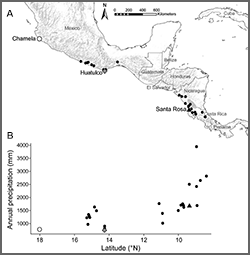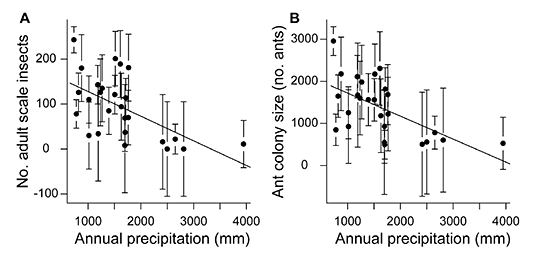
Trees Get By with Ant Aides
What's in the Story?
In a recipe for making a tree, water is a key ingredient. Without water, trees could not grow or produce seeds. Of course, trees live all over the world, and some places are drier than others. In dry places, trees have clever ways of getting by without much water. For example, trees that live in the desert can store water in their leaves. In the PLOS Biology article, “Water Stress Strengthens Mutualism Among Ants, Trees, and Scale Insects,” scientists show that some trees can survive in dry places because of helpful ants.
Amazing Leaves
We may not think about it very often, but leaves of trees and other plants make almost all of our food. By converting the sun's energy into sugars through a process called photosynthesis, plants make food for themselves and for all of the animals that eat them. The next time you walk through your local grocery store, keep in mind that somewhere there were leaves that made it possible.

For leaves to work properly and make food for trees, they must be filled with water. This makes things challenging for trees that live in dry places. Water usually comes from rain. Some people are used to summer and winter seasons, but many places in the world have a rainy season and a dry season instead. Many trees that live in these places have leaves during the rainy season and reduce the number of leaves during the dry season, just as some trees do in the winter.
If a tree goes through the dry season without leaves, it has to use the food it made in the leafy rainy season. Easy, right? Well, it depends. If the dry season is very long compared to the rainy season, the tree may run out of food and die. But this potential danger can be avoided with the help of ant aides.

What Do Ants Have to Do with It?
As anyone who's ever stuck their hand in an ant nest will know, ants are good at defending themselves. A colony of ants has many individuals, and all of them can bite. In tropical countries where it is warm all year, some trees have developed special relationships with defending ants. Ants live inside the tree, and they defend the tree against insects that eat the leaves. It's a good deal for both the trees and the ants.
So, we know that ants defend leaves, and leaves are most important to trees when conditions are dry. Scientists then asked, is leaf defense by ants better when trees live in dry places? To answer this question, the scientists looked at trees and ants in dry places and wet places. In all these places, they measured how good the ants were at defending their tree home.
The result? Ants defended leaves better under drier conditions. This means that trees survive more in dry places because their ants protect their food supply. This is a perfect deal for trees. But, the scientists wondered, can the trees actually encourage their ants to be better defenders when conditions are dry?
Enter the Scale Insects

Ever heard of a scale insect? Maybe not. These weird little insects are like plant vampires. The sugars that plants make in photosynthesis move around the plant as sap in special tubes. The scale insects insert their mouths into these tubes and suck the sap.
Insects are animals, and like all animals, they use some of what they eat to grow and make babies, and they poop out the rest. Plant sap has more sugar than the scale insects can use, so scale insects poop sugar. This makes them a favorite of ants, which can't drink plant sap straight from the plant, but love sugar. That's right, the ants eat the sugary poop from the scale insects.
When ants live inside trees, they often have herds of these sugar-pooping scale insects. It's a lot like people having herds of cows for milk. We can move our cows around a pasture, but the amount of milk we'll get depends on how much grass is growing in the pasture. In the same way, the ants can move their scale insects around the tree, but the amount of sugar that the ants get depends on the tree.
Trees Trade in Sugar
The scientists found that trees in drier places had more scale insects for ants. Does the tree provide more food for ants in drier places to get better defense for their valuable leaves? The scientists answered this question by using math to ask what the trees should do with their sugar under different conditions. They found that trees at drier sites should provide more sugary food to defending ants to avoid losing leaves and dying from starvation. Trees at wetter sites should use their sugars for growth instead of giving them away to the ants.

Ant Insurance
If your parents have a car, they buy car insurance. They have to pay a small amount of money every year to the insurance company. If the car is damaged in an accident, it may be very expensive to fix it. But because your parents have car insurance, the insurance company pays the bill.
The scientists reasoned that a similar thing was happening with trees and ants. Trees that live in very dry places have more scale insects to get sugar out of the trees to pay the ants. Ants then do a great job of defending the leaves in the rainy season, so that the tree has enough food to survive the next dry season. Voila, ant insurance! And the bills are paid in sugar.

Additional images by L. Shyamal, Vijay Cavale, and Alex Wild, - via Wikimedia Commons.
Bibliographic details:
- Article: Trees Get By with Ant Aides
- Author(s): Elizabeth G. Pringle
- Publisher: Arizona State University School of Life Sciences Ask A Biologist
- Site name: ASU - Ask A Biologist
- Date published: 13 Dec, 2013
- Date accessed:
- Link: https://askabiologist.asu.edu/plosable/trees-aided-ants
APA Style
Elizabeth G. Pringle. (Fri, 12/13/2013 - 09:58). Trees Get By with Ant Aides. ASU - Ask A Biologist. Retrieved from https://askabiologist.asu.edu/plosable/trees-aided-ants
Chicago Manual of Style
Elizabeth G. Pringle. "Trees Get By with Ant Aides". ASU - Ask A Biologist. 13 Dec 2013. https://askabiologist.asu.edu/plosable/trees-aided-ants
Elizabeth G. Pringle. "Trees Get By with Ant Aides". ASU - Ask A Biologist. 13 Dec 2013. ASU - Ask A Biologist, Web. https://askabiologist.asu.edu/plosable/trees-aided-ants
MLA 2017 Style

Be Part of
Ask A Biologist
By volunteering, or simply sending us feedback on the site. Scientists, teachers, writers, illustrators, and translators are all important to the program. If you are interested in helping with the website we have a Volunteers page to get the process started.
